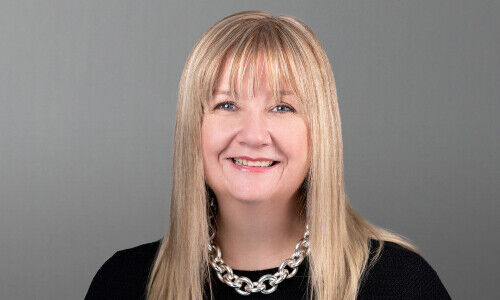She thought no one would notice her in the Credit Suisse «engine room». But then, people told her, don’t miss the job, you got a huge responsibility. And that’s when Joanne Hannaford realized that she is the first Chief Technology Officer sitting on the Executive Board for years, she says in an interview with finews.asia.
Joanne Hannaford, why did you take a job at Credit Suisse?
There are two answers. The first is the obvious one. As a senior technologist from Britain, I wanted to work in Europe. One of the premier jobs in Europe in this area is at Credit Suisse. This, therefore, was an amazing opportunity.
I thought no one would notice me in the Credit Suisse engine room. But someone wrote me, don’t miss the job, you got a huge responsibility. And that’s when I realized that I am the first Chief Technology and Operations Officer (CTOO) sitting on the Executive Board for years.
«I spent my entire career at Goldman Sachs living between London and New York»
I was interviewing before some of last year’s events. After Archegos erupted, Thomas Gottstein (the former CEO of Credit Suisse) called me up and asked me if I still want the job, and I said more than ever.
Why?
It’s all a question of mindset. I think that for companies, technology is a fabric that drives differences in people's work, in innovation, and in agility, indeed in culture.
This was one answer. What’s the other one?
That one is more personal which is I wanted to live in Switzerland, learn German, and therefore really challenge myself a bit.
How?
I spent my entire career at Goldman Sachs living between London and New York. I learned a very American narrative until I considered Credit Suisse and realized that there is a completely different narrative. I think that I can really help Credit Suisse.
Weren’t you reluctant as Credit Suisse was experiencing rather difficult times?
It may sound crazy but no. There is work that needs to happen at Credit Suisse and I do see this as an opportunity for a much stronger bank to emerge, built on a rich heritage of more than 160 years. There are tough moments in every company, but we have the team and strategy in place to strengthen the bank.
If you look at the Executive Board now, it is comprised of people that are true specialists as they have done their jobs for decades. It would be crazy if someone would say to me, don’t do technology, do another job.
«Suddenly all parts click»
Furthermore, Credit Suisse has an amazing franchise. It’s the second-largest wealth manager in the world outside the U.S. I like to think that Credit Suisse is like a Rubik’s Cube. Suddenly all parts click. The strategy we recently presented is a very comprehensive one. We have already put so much work into it and now we need to show that we can deliver.
Credit Suisse employs several hundred engineers in Singapore who develop solutions and tools for the bank globally. Why is that so?
Yes, we have a fantastic team in Singapore that is creating solutions predominantly for the Wealth Management business globally. What I see is that the Asia market embraces technology in a highly open and receptive way. We must harness that and amplify it globally.
Why is that so?
Clients in Asia are very receptive. In addition, Credit Suisse has digitally combined wholesale banking services from retail banking to wealth management, to what CSX (a digital tool) is today. Very few banks have done that. Singapore offers the expertise to further develop that offering. For us, it has always been clear that our platform goes beyond the boundaries of Switzerland. One of the outcomes of the pandemic is that we developed and launched a number of new digital products.
Does each business within Credit Suisse need a different platform?
No, generally you would be better off in finding best-in-class common platforms that provide scalability. You need to make them excellent so that you can load more business on them. And this leads finally to the question of how I am reducing costs and innovating at the same time.
How different is a bank like Goldman Sachs where you previously worked compared to Credit Suisse?
We are moving from applications to platforms to services and APIs. In a trading business like at Goldman Sachs, you get APIs very quickly. At Credit Suisse, our infrastructure is different as we have differing products and platforms with individual requirements across both Wealth Management and cross-asset trading platforms.
«As a financial services firm, it may not be the best to be the first mover»
We are now investing in shared capabilities such as a single data fabric. Overall, this is an opportunity as we can continuously consider how we create value for our clients and deliver better products to them.
Is the cloud the next big thing for banks?
I don’t think it is a question about what the next big thing is. In my view, it is more about taking the best parts from all areas of technology to create the best solutions. As a financial services firm, it may not be the best to be the first mover. And we also don’t want to be the last, but probably the second or the third.
The evolution of the internet (technology) is a lot about trust, and this particularly pertains to the cloud. And taking Switzerland as an example, people think of the protection of privacy, trust, and excellence. In this context, I am therefore very much interested commercially in how that differentiates our offering. We need to increasingly think about what software sits in the cloud, as opposed to a wholesale movement of data.
What is your view on the metaverse?
It’s quite amazing, this world of images. Therefore, I think it must be taken seriously despite it being early days. However, Credit Suisse will not be the first mover in that field.
Some banks conquer the metaverse already.
In fact, we have started testing. For example, we organized a competition for clients, creating a Credit Suisse presence in a metaverse. But it is still in the experimentation bucket. All this comes with our ambition that innovation must include every voice within the bank. Everybody’s voice counts. I encourage people to send me their ideas. This fosters innovation.
Is Credit Suisse developing services for digital assets?
Specifically, in the Swiss Bank, we realized that our wealth management clients expect us to be a custodian of digital assets and to access these services. So, yes, we are actively working on that.
«I programmed my entire career»
The amazing thing about Switzerland is that some of the tech firms are astounding. The depth of their expertise is unique, considering that ETH Zurich is one of the best universities outside of MIT. And! We (Credit Suisse and ETH Zurich) have the same founder, Alfred Escher.
How did you enter the tech sector as it is quite a male-dominated world?
Looking back to when I started my career – until 1985 computer technology was not considered something exclusively for men. Everybody could work in this industry. In fact, my math teacher started a programming club during lunchtime that I attended. So, after that, I programmed my entire career.
My first job was at Merrill Lynch, where the IT department consisted of around 60 percent of women. It is only in the last 15 years that this has changed so much. But none questions why.
Were you particularly good at math?
No, just average, but this is not what firms were looking at, more at people that were good at philosophy.
Why?
Because philosophy is very logical. I was ok at math but great in theology and philosophy!
How can a bank apply Artificial Intelligence (AI)?
You must use it responsibly, particularly in financial services. We have to be very astute with data sets, very careful in all actions by a machine, and make sure why it is taking those actions.
«There are only a few Robo-advisers in the world that are successful»
The big dilemma of AI in financial services is determinism. What I mean by that is, AI can make suggestions, but a human being always needs to verify these suggestions. Whether we will ever get to the point where it becomes completely autonomous and self-deterministic is hard to predict.
That’s why Robo-advisers work best on a hybrid model.
There are only a few Robo-advisers in the world that are successful, because of the issues I just mentioned. Furthermore, the regulators expect that financial institutions, including Robo-advisors, can describe how something works. And this is exactly the intrinsic problem. Having said that, the definition of AI finally relies on who really makes the decision.
What are your next steps with Credit Suisse?
We are defining a series of platforms and identifying them by our needs. In fact, we are creating the formalization of how you commoditize them for the firm. That’s a milestone. I think we are the only bank in Europe that is doing this in such a formalized way.
We are going to each business area targeting the architecture and identifying what platform it needs. Furthermore, we are actively working on a new-age cloud strategy, and we will likely end up by having our own cloud platform that takes the best bits from all over.
Joanne Hannaford is a British citizen from London. She has been Chief Technology & Operations Officer (CTOO) at Credit Suisse (CS) since this year. Prior to that, she worked for 25 years in various functions at the US bank Goldman Sachs, most recently in the rank of partner. In the 1990s, she studied computer science at Anglia Ruskin University in the UK and earned her bachelor's degree in computer science at Staffordshire University in the UK. She then worked first at Merrill Lynch, later for a year at UBS and then at NatWest Bank.























